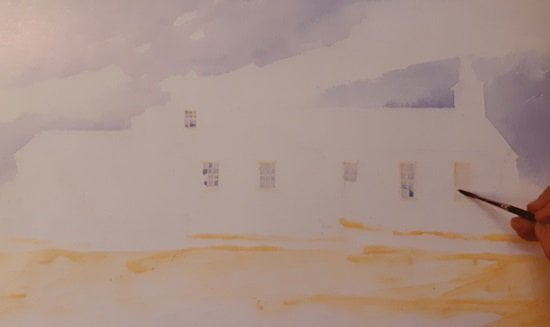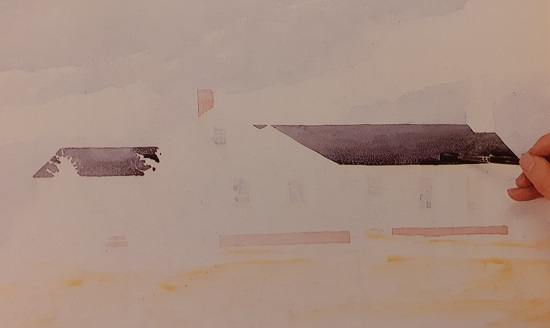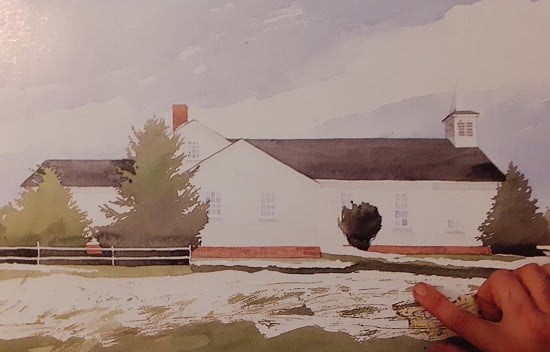Since watercolors are transparent it is impossible adding layers of light color over dark. That’s why you need to plan the entire painting ahead and leave the areas you want to be lighter unpainted and paint around them. Let’s assume you want to paint the sea and that you want to leave the tiny spots of white paper unpainted so you can depict the reflections of the sun on the water surface.
Trying to add wide, smooth spreads of paint around those tiny spots can be really impossible. The solution for a situation like that is to use masking fluid to temporarily protect those white areas while you are painting the rest of the surface freely.
Masking fluid is a rubbery liquid that you can purchase in bottles and it is added to the paper with a brush only on the spots which whiteness you want to preserve. After you added it drys really quickly in a minute or two and you can paint over or around it without the danger of coloring the surfaces you wanted to leave uncolored.
After you finished the rest of the painting you can simply remove masking fluid with your finger or an eraser, it goes off very easily. One thing you should know is that once you used a brush to add masking fluid you should rinse it with warm water without letting the fluid dry on it, that will destroy your paintbrush.
Luckily it is easily removed from the bristles while it’s still wet simply use lukewarm water and neutral soap. It might be the best using some old brush or just buy a synthetic one that you will use only for adding masking fluid.
Painting The Snow
To paint this you will need the following:
- One primmed sheet of cold-pressed 285g/m2 aquarelle paper
- Two old paintbrushes ( one small and one wide ) for adding the masking fluid
- Round sable bristle brush number 12
- Round sable bristle brush number 3
- Masking liquid
- HB pencil
- Ruler
And the following colors:
- French Ultramarine
- Cobalt Blue
- Pein Blue
- Ochre Yellow
- Brown-red- Alizarine
- Raw Brown
- Green
Masking fluid is essential if you want to preserve the whiteness of small areas on your painting but you can also use it to preserve the whiteness of large areas that need to remain white like when you paint winter scenery with large amounts of snow.
Sketching
Use the HB pencil to sketch the scene. If necessary use the ruler so it is easier for you to draw some elements of the house. Mask the window frames adding the masking fluid with a small brush.
For the large pile of snow in the front plane of the painting use the large brush to add masking fluid with wide uneven moves. Make sure you leave small spots of the paper uncovered so you can add the green between them making it look like some grass is under the snow.
Let the masking fluid dry for at least ten minutes before you start painting.
To paint the sky make light blue out of heavily diluted cobalt blue. Add the paint with wide moves using the round brush number 12. Leave the areas of paper uncolored to represent the clouds. Soften the edges of the clouds with a wet paintbrush. Use the same color to paint the windows using round brush number 3.
Make a very diluted mixture of Pane Grey with a little bit of Ochre Yellow and paint the house and the bell tower at the top using round brush number 3.
Adding The Details
For the details of the bricks in the base wall of the house make a light mixture of Brown-Red ALizarine and Ochre Yellow. Use the same mixture to color the chimney on the left. Paint the roof with diluted Pane Grey.
To paint the shadows on the bell tower use Pane Grey. For the shadows under the roof and under the windows use pale blue-grey that you got by mixing French Ultramarine with just a little bit of Pane Grey.
Paint the brick patterns on the wall using the mixture of Brown-Red Alizarine, Ochre Yellow and just a tiny bit of Raw Umber. Add the color with short horizontal moves leaving little space in between to depict the pattern of bricks.
Mix a dark solution of Pane Grey and add some texture to the roof painting a strain of thin horizontal lines. Paint the fence with a heavily diluted mixture of Pane Grey and a bit of Raw Umber. Use the same paint but less diluted to paint the windows on the bell tower.
For the grass in the front plane use the mixture of green, Ochre Yellow and Raw Umber. Using the brush number 12 paint over the masking fluid with wide brush strokes. Masking fluid will protect the paper beneath it. Leave everything to dry well.
Paint the pine trees in the front plane using green, Raw Umber and Pane Grey changing the ratio in the mixtures in order to get different tones of green. Use the tip of the paintbrush to paint thin branches and the texture of the leaves.
Use darker mixture for the bottom end of the trees right next to the fence. For the trees in the distance use Raw Umber and a bit of green. Leave the painting to dry.
Finishing Touches
Once the painting is fully dry remove the masking fluid. Rub the layer of masking liquid with your finger hard until all the masking rubber falls off the paper. You will notice how the green paint went through the areas between the layer of masking fluid creating the impression of grass going through the melting snow.
To finish the painting mix a dark spread of green, Raw Umber and Pane Grey and paint again over the tress using the round brush number 3 leaving some areas of the previous lighter paint to be seen.
Use the same mixture and add it a little bit of Cobalt Blue and a lot of water to dilute it heavily and paint dark shadows on the windows. For the end add the same but darker mixture to the upper rim of the bricks. Leave your painting to fully dry and then additionally work on certain lines on the roof using HB pencil.
If you have any questions or need any help feel free to leave them in the comment section and I will help in any way I can. Have fun!








0 Comments